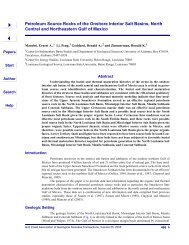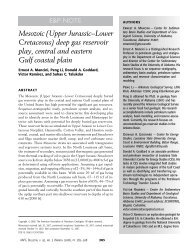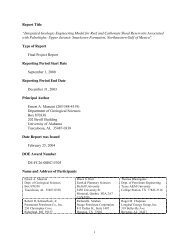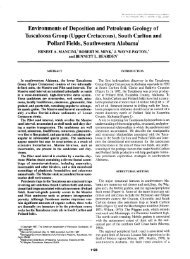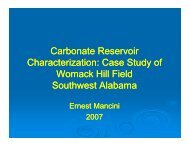Part 4 - Berg - Hughes Center
Part 4 - Berg - Hughes Center
Part 4 - Berg - Hughes Center
You also want an ePaper? Increase the reach of your titles
YUMPU automatically turns print PDFs into web optimized ePapers that Google loves.
the high iron content seems to support the existence of the pre-Norphlet unconformity.<br />
From subsurface control, it appears as though the salt is laterally continuous and<br />
underlies parts of Texas, Arkansas, Alabama, and Mississippi, and nearly all of Louisiana<br />
(Andrews, 1960). A maximum thickness of 1,300 ft was recorded in the Placid No. 3<br />
Freeman-Smith (Sec. 14, T. 16 S., R. 13 W.), Calhoun County, Arkansas, and more than<br />
3,300 ft (still in salt at total depth of 14,890 ft) in the C.V.O.C. No. 2 Banks well (Sec.<br />
34, T. 21 N., R. 10 W.), Webster Parish, Louisiana. The thickness is believed to be<br />
associated with salt flowage, and may have been the result of basinward thickening of the<br />
salt. An original deposition of about 5,000 ft of bedded salt has been postulated but<br />
because of the topographically irregular floor of the basin, the thickness was not uniform<br />
(Parker and McDowell, 1955; Andrews, 1960). Bishop (1967) reported that precipitation<br />
of as much as 5,000 ft of Louann Salt was the result of concentrated marine waters<br />
flowing periodically into the basin, more or less isolated from the open sea by barrier<br />
bars. The CaCO3 and CaSO4 were precipitated, and the produced concentrated brines of<br />
NaCl were deposited in the basin.<br />
Upper Jurassic Louark (Norphlet, Smackover, Haynesville-Buckner)<br />
Norphlet Formation<br />
The Norphlet unconformably overlies the Louann Salt and older units near the<br />
margins of the basin where the Louann was not deposited or has been removed by<br />
erosion. Based on the relation of the Norphlet to the overlying Smackover, it has been<br />
assigned to the Upper Jurassic (Hazzard et al., 1947; Bishop, 1967). The Norphlet of<br />
Arkansas, Louisiana, and Texas attains a maximum thickness of about 150 ft and is<br />
composed primarily of red and gray shale and sandstone. The northernmost area of<br />
351




